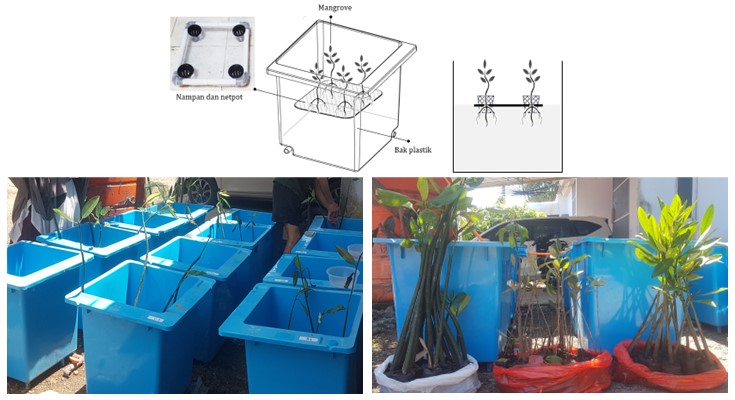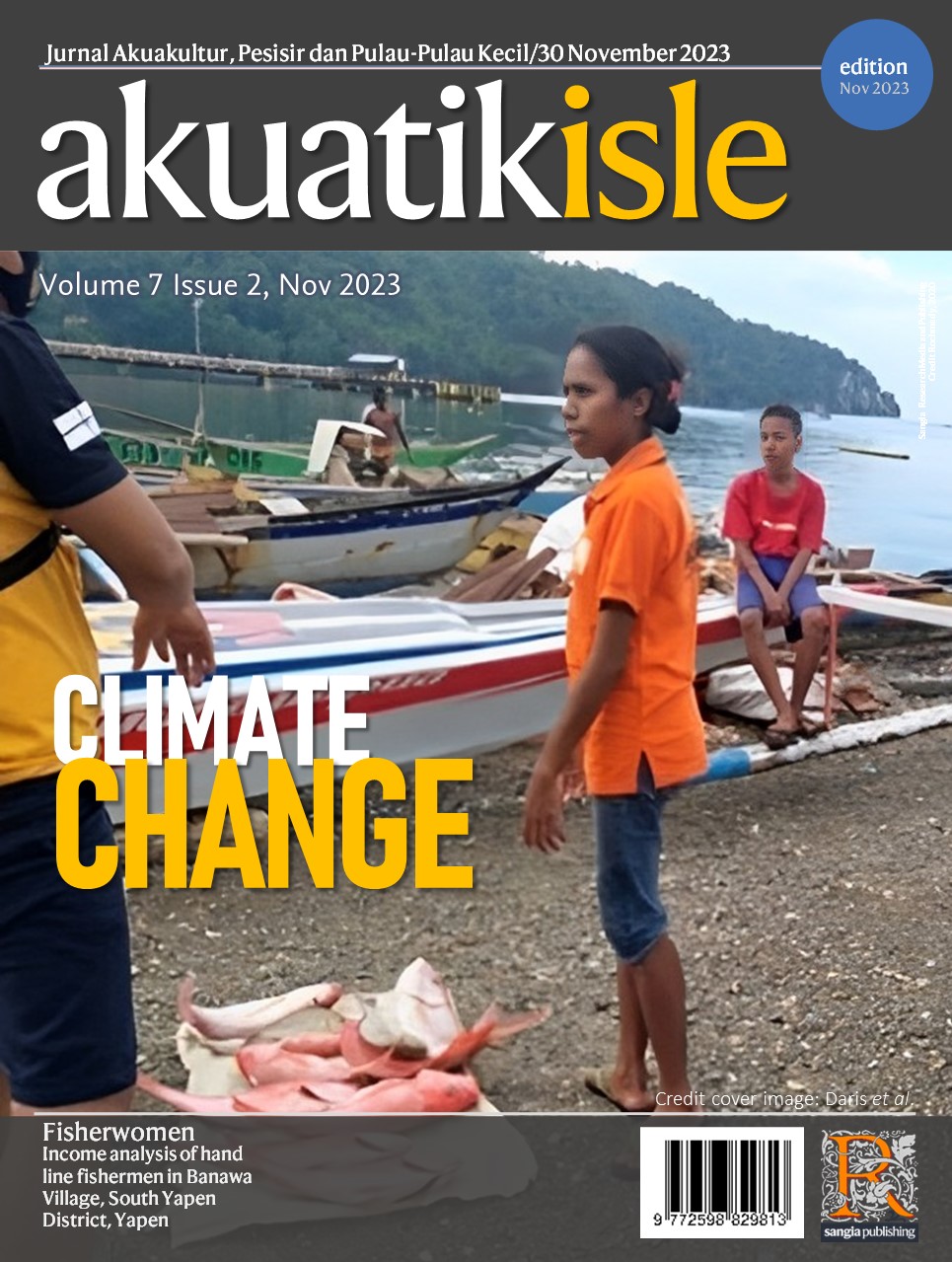Akuatikisle: Jurnal Akuakultur, Pesisir dan Pulau-Pulau Kecil
Full Length Article
Bio-desalination of sea water using floating plants; A laboratory experiment on three mangroves species
Highlights
Generate NLP AI by Wizdam ID.
Abstract
The plant species mangrove has been knowed to be effective for the bio-desalination process. However, there is currently no scientific evidence supporting the ability of mangrove bio-desalination when implemented through the floating method. This laboratory-scale study aimed to evaluate the bio-desalination of several mangrove species using the floating method. This study consisted of four treatments and three replicates. Treatments included a control group without mangroves (treatment A) and three treatments using mangroves (treatments B, C, and D), Bruguiera sp., Rhizophora sp., and Avicennia sp., which were positioned floating in a tank using a tray. During the eight weeks of rearing, nutrients were provided through 60 mL liquid NPK fertilization. The results showed that there was a decrease in salinity concentration in all mangrove treatments between 22.5-23.9 ppt from the initial salinity of 30 ppt. Different results were observed for the treatment without mangroves, and the salinity concentration tended to increase until the end of the research to 31.6 ppt. The highest Salinity Reduction Efficiency (SRE) was achieved by Avicennia sp.. (25.1%), followed by Rhizophora sp. (22.8%), and the lowest in Bruguiera sp. (20.3%). The results of this study showed that bio-desalination using mangroves had a significant effect on SRE, and each treatment indicated a significant difference (p<0.05). The results of this study provide initial evidence of the potential of the mangrove floating method for bio-desalination of seawater into brackish water.
Keywords
Introduction
Section snippets
Material and Methods
Materials and methods from the full-text PDF of this article cannot be displayed.
Results
Results from the full-text PDF of this article cannot be displayed.
Discussion
Discussion from the full-text PDF of this article cannot be displayed.
Conclusions
Conclusions from the full-text PDF of this article cannot be displayed.
Acknowledgment
Acknowledgment from the full-text PDF of this article cannot be displayed.
Competing interest
The authors declare that they have no known competing financial interests or personal relationships that could have appeared to influence the work reported in this paper.
Conflict of interest
The authors declare that the research was conducted in the absence of any commercial or financial relationships that could be construed as a potential conflict of interest.
Ethical approval acknowledgements
No ethical approval required for this article. All procedures followed were in accordance with the ethical standards of the responsible committee on human experimentation (institutional and national) and with the Helsinki Declaration of 1975, as revised in 2008 (5)
Supplementary files
Data sharing not applicable to this article as no datasets were generated or analysed during the current study, and/or contains supplementary material, which is available to authorized users.
References (1)
Akter, R., Hasan, N., Reza, F., Asaduzzaman, M., Begum, K., & Shammi, M. (2023). Hydrobiology of saline agriculture ecosystem: A review of scenario change in South-West Region of Bangladesh. Hydrobiology, 2(1), 162–180. https://doi.org/10.3390/hydrobiology2010011
Bi, R., Zhou, C., Jia, Y., Wang, S., Li, P., Reichwaldt, E. S., & Liu, W. (2019). Giving waterbodies the treatment they need: A critical review of the application of constructed floating wetlands. Journal of Environmental Management, 238(October 2018), 484–498. https://doi.org/10.1016/ j.jenvman.2019.02.064
Chimayati, R. L., & Titah, H. S. (2019). The Ability of Avicennia marina in decreasing salinity and COD levels in the bio-desalination process. International Journal of Science and Research (IJSR), 8(1), 619–621. https://www.ijsr.net/ archive/v8i1/ART20194237.pdf
Hamuna, B., Tanjung, R. H. R., Suwito, S., Maury, H. K., & Alianto, A. (2018). Study of seawater quality and pollution index based on physical-chemical parameters in the waters of the Depapre District, Jayapura. Jurnal Ilmu Lingkungan, 16(1), 35–43. https://doi.org/10.14710/jil.16.135-43
Hastuti, E. D., Izzati, M., & Prihastanti, E. (2023). Water uptake and salt accumulation under Rhizophora stylosa seedling planted in controlled salinity and inundation levels. AACL Bioflux, 16(2), 1069–1076.
Heriansah, Kabangnga, A., & Nursida, N. F. (2023). Panduan pembuatan dan penggunaan wadah apung tanaman untuk riset akuakultur multi-trofik. Hak Cipta Nomor Pencatatan: 000443037. Kementerian Hukum dan Hak Asasi Manusia Republik Indonesia.
Jeen, S. W., Kang, J., Jung, H., & Lee, J. (2021). Review of seawater intrusion in western coastal regions of south korea. Water (Switzerland), 13(6), 1–27. https://doi.org/10.3390/ w13060761
Kim, K., Seo, E., Chang, S. K., Park, T. J., & Lee, S. J. (2016). Novel water filtration of saline water in the outermost layer of mangrove roots. Scientific Reports, 6(October 2015), 1–9. https://doi.org/10.1038/srep20426
Li, F., Feng, J., Zhou, X., Xu, C., Haissam Jijakli, M., Zhang, W., & Fang, F. (2019). Impact of rice-fish/shrimp co-culture on the N2O emission and NH3 volatilization in intensive aquaculture ponds. Sci. of the Tot. Env., 655, 284–291. https://doi.org/10.1016/j.scitotenv.2018.10.440
Li, T., Zhang, B., Zhu, C., Su, J., Li, J., Chen, S., & Qin, J. (2021). Effects of an ex situ shrimp-rice aquaponic system on the water quality of aquaculture ponds in the Pearl River estuary, China. Aquaculture, 545(June), 737179. https://doi.org/ 10.1016/j.aquaculture.2021.737179
Macchiavello, J., & Bulboa, C. (2014). Nutrient uptake efficiency of Gracilaria chilensis and Ulva lactuca in an IMTA system with the red abalone Haliotis rufescens. Latin American Journal of Aquatic Research, 42(3), 523–533. https://doi.org/10.3856/vol42-issue3-fulltext-12
Nizam, A., Meera, S. P., & Kumar, A. (2022). Genetic and molecular mechanisms underlying mangrove adaptations to intertidal environments. IScience, 25(1), 103547. https://doi.org/10.1016/j.isci.2021.103547
Osti, J. A. S., do Carmo, C. F., Silva Cerqueira, M. A., Duarte Giamas, M. T., Peixoto, A. C., Vaz-dos-Santos, A. M., & Mercante, C. T. J. (2020). Nitrogen and phosphorus removal from fish farming effluents using artificial floating islands colonized by Eichhornia crassipes. Aquaculture Reports, 17(April). https://doi.org/10.1016/j.aqrep.2020.100324
Prusty, P., & Farooq, S. H. (2020). Seawater intrusion in the coastal aquifers of India - A review. HydroResearch, 3, 61–74. https://doi.org/10.1016/j.hydres.2020.06.001
Puspaningrum, T. C., & Titah, H. S. (2020). The removal of salinity in a reed bed system using mangroves and bacteria in a continuous flow series reactor. J. of Eco. Eng. , 21(6), 212–223. https://doi.org/10.12911/ 22998993/124075
Raju, R. D., & Arockiasamy, M. (2022). Coastal protection using integration of mangroves with floating barges : An innovative concept. J. Mar. Sci. Eng., 10(612), 1–15.
Saeni, M., & Tanasale, M. (1999). Desalinasi air laut dengan tanaman mangrove. Buletin Kimia, 14, 1–21.
Sanicola, O., Lucke, T., Stewart, M., Tondera, K., & Walker, C. (2019). Root and shoot biomass growth of constructed floating wetlands plants in saline environments. Int. J. of Environmental Research and Public Health, 16(2), 1–11. https://doi.org/10.3390/ijerph16020275
Shahid, M. J., Al-surhanee, A. A., Kouadri, F., Ali, S., Nawaz, N., Afzal, M., Rizwan, M., Ali, B., & Soliman, M. H. (2020). Role of microorganisms in the remediation of wastewater in floating treatment wetlands : A Review. Sustainability, 1–29.
Silva, W. De, & Amarasinghe, M. (2021). Response of mangrove plant species to a saline gradient : Implications for ecological restoration. Acta Botanica Brasilica, 35(1), 151–160. https://doi.org/10.1590/0102-33062020abb0170
Sinyo, Y., Tolangara, A., Saibi, N., & Sabtu, R. (2022). Analisis salt content pada media akar dan daun mangrove secreter Avicennia sp. Edukasi, 20(2), 197–205.
Titah, S. H., Fitri Purwanti, I., Pratikno, H., Layina Chimayati, R., Handayanu, Rozaimah Sheikh Abdullah, S., & Izzati Ismail, N. (2020). The ability of Avicennia marina to uptake ions of sodium and chloride in reed bed system reactor. E3S Web of Conferences, 202.
Venkatachalam, S., Kandasamy, K., & Krishnamoorthy, I. (2018). Survival and growth of fi sh (Lates calcarifer) under integrated mangrove- aquaculture and open-aquaculture systems. Aquaculture Reports, 9(November 2017), 18–24. https://doi.org/10.1016/j.aqrep.2017.11.004
Wang, Y., Lee, J., Werber, J. R., & Elimelech, M. (2020). Capillary-driven desalination in a synthetic mangrove. Science Advances, 6(8). https://doi.org/10.1126/sciadv.aax5253
Yang, X., Li, T., Xia, Y., & Prasad, R. (2020). Microbial fuel cell coupled ecological floating bed for enhancing bioelectricity generation and nitrogen removal. International Journal of Hydrogen Energy, xxxx, 1–12. https://doi.org/10.1016/ j.ijhydene.2020.08.051
Yusniawati, Mukarlina, & Wardoyo, E. (2017). Pertumbuhan semai bakau putih (Bruguiera cylindrica) pada tingkat salinitas yang berbeda. Jurnal Protobiont, 6(3), 31–36.
Bibliographic Information
Cite this article as:
-
Submitted
22 October 2023 -
Accepted
12 November 2023 -
Published
12 November 2023 -
Version of record
23 July 2024 -
Issue date
30 November 2023
-
Academic subject
Marine Sciences
Copyright
Sangia Advertisement
Copyright © 2023 Mesalina Tri Hidayani, Sri Wulandari, Heriansah, Elmi Novrianti Agusma. Sangia Research Media and Publishing. Production and hosting by Sangia (SRM™).  This work is licensed under a Creative Commons Attribution-ShareAlike 4.0 International License.
This work is licensed under a Creative Commons Attribution-ShareAlike 4.0 International License.
Disclaimer: All claims expressed in this article are solely those of the authors and do not necessarily represent those of their affiliated organizations, or those of the publisher, the editors and the reviewers. Any product that may be evaluated in this article or claim that may be made by its manufacturer is not guaranteed or endorsed by the publisher.
Comments on this article
By submitting a comment you agree to abide by our Terms and Community Guidelines. If you find something abusive or that does not comply with our terms or guidelines please flag it as inappropriate.










